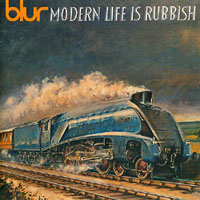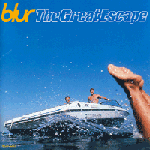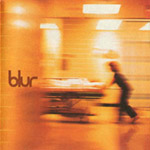







Leisure
(1991)
She's
So High
Bang
Slow Down
Repetition
Bad Day
Sing
There's No Other Way
Fool
Come Together
High Cool
Birthday
Wear Me Down
|
The
Great Escape
Jubilee Popscene End Of A Century Tracy Jacks Mr. Robinson Quango To The End Fade Away It Could Be You Stereotypes She's So High Girls & Boys Advert Intermission Bank Holiday For Tomorrow Country House This Is A Low Supa Shoppa |
Yuko
And Hiro
He Thought Of Cars Coping Globe Alone Parklife The Universal |
Originally called Seymour, the group was formed in London in 1989 by Damon Albarn, Graham Coxon, and Alex James, with David Rowntree joining the lineup shortly afterward. After performing a handful of gigs and recording a demo tape, the band signed to Food Records, a subsidiary of EMI run by journalist Any Ross and former Teardrop Explodes keyboardist Dave Balfe. Balfe and Ross suggested that the band change their name, submitting a list of alternate names for the group's approval. From that list, the group took the name Blur.
She's So High, the group's first single, made it into the Top 50 while the follow-up There's No Other Way went Top Ten. Both singles were included on their 1991 Stephen Street-produced debut album, Leisure. Although it received favourable reviews, the album fit neatly into the dying Manchester pop scene, causing some journalists to dismiss the band as manufactured teen idols. For the next two years, Blur struggled to distance themselves from the scene associated with the sound of their first album.
Released in 1992, the snarling Pop Scene was Blur's first attempt at changing their musical directions. Despite Blur's clear artistic growth, Pop Scene didn't fit into the climate of British pop and American grunge in 1992 and failed to make an impression on the UK charts. Following the single's commercial failure, the group began work on their second album, Modern Life Is Rubbish, a process that would take nearly a year and a half.
 XTC's
Andy Partridge was originally slated to produce Modern Life Is Rubbish,
but the relationship between Blur and Partridge quickly soured, so Stephen
Street was again brought in to produce the band. After spending nearly a
year in the studio, the band delivered the album to Food.
The record company rejected
XTC's
Andy Partridge was originally slated to produce Modern Life Is Rubbish,
but the relationship between Blur and Partridge quickly soured, so Stephen
Street was again brought in to produce the band. After spending nearly a
year in the studio, the band delivered the album to Food.
The record company rejected
the album, declaring that it needed a hit single. Blur
went back into the studio and recorded Albarn's For
Tomorrow, which would turn out to be a British hit.
Food was ready to release the record, but the group's US record company,
SBK, believed there was no American hit single on the record and asked them
to return to the studio. Blur complied and recorded Chemical
World, which pleased SBK for a short while; the song would become
a minor alternative hit in the US and charted at number 28 in the UK. Modern
Life Is Rubbish was set for release in the spring of 1993 when SBK asked
Blur to re-record the album with producer Butch Vig.
The band refused and the record was released in May in Britain; it appeared
in the United States that fall. Modern Life Is Rubbish received good
reviews in Britain, peaking at number 15 on the charts, yet it failed to
make much of an impression in the US.
Modern Life Is Rubbish turned out to be a dry run for Blur's breakthrough album, Parklife. Released in April 1994, Parklife entered the charts at number 1 and catapulted the band to stardom in Britain. The stylized new wave dance-pop single Girls And Boys, entered the charts at number 5; the single managed to spend 15 weeks in the US charts, peaking at number 52, but the album never cracked the charts. It was a completely different story in England, as Blur had a string of hit singles including the ballad To The End and the mod anthem Parklife, which featured narration by Phil Daniels, the star of the film version of the Who's Quadrophenia.
With the
success of Parklife, Blur opened the door for
a flood of British indie-guitar bands that dominated British pop culture
in the mid-90s. By the beginning of 1995, Parklife had gone triple
platinum and the band had become superstars. The group spent the first half
of 1995 recording their fourth album and playing various one-off concerts.
Blur released Country House, the first single
from their new album, in August admist a flurry of media attention because
Albarn had the single's release moved up a week to compete with the release
of Roll With It, a new single from Blur's chief rivals, Oasis.
The strategy backfired. Although Blur won the battle,
with Country House becoming the group's first
number one single, they ultimately lost the war, as Oasis became Britain's
biggest band with their second album, What's The Story, Morning Glory?,
completely overshadowing the follow-up to Parklife, The Great
Escape. While The Great Escape entered
the UK charts at number 1 and earned overwhelmingly positive reviews, it
sold in smaller numbers and by the beginning of 1996, Blur were seen as
has-beens, especially since they once again failed to break the American
market, where Oasis had been particularly successful. 
13 followed in 1999. 13 represents a break with the past in many ways. It is the first album on which the group haven't collaborated with producer Stephen Street. The new way of working involved lengthy improvisations around song structures which William Orbit and his crew would painstakingly record and edit. The result is a sound at once abstract and yet crowded with detail and inspiring moments. 13 also has its roots in all kinds of changed personal and emotional circumstances. It is the sound of a group maturing into a fully realized musical whole, making the music that best expresses them at present: from Tender, an epic gospel hymn of consolidation described by bassist Alex James as "one of the best things we've ever done. It's going to f**king knock people out," to the anguished yet hopeful blues of No Distance Left To Run, from the lo-fi pop cool of Graham Coxon's Coffee & TV to the alluring strangeness Battle and Mellow Song. The song Trailer Park, which originally was written for the South Park album, is a splendid Kraut Rock/mutant hybrid. 13 is the sound of a group with the happy and enviable position of inhabiting a soundworld that is utterly their own vision and creation. 13 is Blur's sixth album and marks the band being together for 10 years.
 BLUR
BLUR
Blur Official Site
Blur
Studio
BFC -- the
official blur fan service
Blurred For Life
Damon Nation
Graham
Coxon - You're So Great
FOOD RECORDS
Food Records
EMI RECORDS
EMI Records
TRANSCOPIC
Transcopic
TEARDROP EXPLODES
AMG
All Music Guide
XTC
XTC Microsite
GARBAGE
Garbage - Version 2.0
THE WHO
The Who Live - The Blues
to the Bush - Official Tour Site
WILLIAM ORBIT
William Orbit -
Orbit Online
MICHAEL NYMAN
Michael
Nyman
OASIS
The Official Oasis Website
QUADROPHENIA - THE
MOVIE
Quadrophenia
- imdb.com
FACE - THE MOVIE
Face - imdb.com
RAVENOUS - THE MOVIE
SOUTH PARK
Comedy
Central- South Park